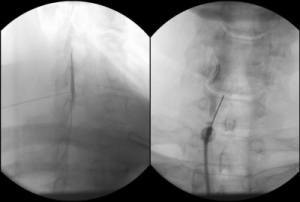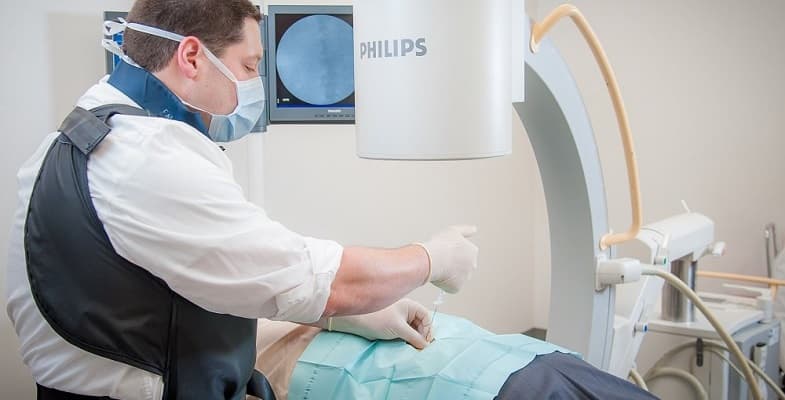What Is A Cervical Epidural Steroid Injection?
A cervical epidural steroid injection is a treatment method for pain in the neck and the upper region of the back. Upper back and neck pain reportedly affects 50-80% of adults at some point in their lives. There are numerous conditions that may cause neck and upper back pain such as cervical radiculitis, a herniated disc, strained muscles, and pinched nerves.
Cervical radiculitis occurs due to excessive pressure that is placed on spinal nerves, especially in the neck region, causing the nerves to become irritated and inflamed. The inflamed nerves extend from the spinal cord into various areas of the body and, because nerves are responsible for pain signal transmission, damaged nerves can result in chronic pain. Patients who have cervical radiculitis typically report experiencing sharp pains that shoot down one of the arms as well as weakness and numbness in the extremities.
One of the most effective forms of treatment for cervical radiculitis and chronic neck pain is a cervical epidural steroid injection. Research shows that an epidural steroid injection can rapidly reduce pain and completely alleviate pain for some individuals. The mechanism of action for steroid injections is still being studied, but it has been proposed that the medication, particularly the steroid that is injected, targets inflammation. Steroids also have additional useful properties that make them especially effective, which include an ability to promote the stability of the membranes surrounding the nerves and to hinder the conduction of ions. These processes are associated with reduced pain.
A meta-analysis study that focused on reviewing clinical reports regarding the effectiveness and safety of steroid injections, included data that was obtained over a span of ten years. The results showed strong support for the administration of epidural steroid injections to treat chronic pain.
The effects of steroid injections are generally long-term, but the mechanism that is responsible for this effect is still unclear. It has been concluded, however, that repeated injections that are performed over a one-year period can improve the long-term effects of the injections.
How Are Cervical Epidural Steroid Injections Performed?
In order to understand the injection procedure and where the medication is injected, a brief description of the spinal region will first be explained. The spinal region includes a column of individual bones, called vertebrae, that encase and protect the spinal cord. A vast number of nerves extend out from the spinal cord to the rest of the body. The spinal cord is held in place by a strong membrane. Directly outside of the membrane is a region known as the epidural space, where nerve roots are located. This is the area in which steroids are injected if nerves become pinched, damaged, or inflamed.
Before the injection procedure begins, topical anesthesia is applied to the skin. Next, in order to prevent healthy nerve roots from being exposed to too much medication, the physician will use imaging technology such as fluoroscopy to guide the insertion of the needle and to confirm its correct placement in the epidural space. In addition, contrast dye is typically injected in order to observe where the medication will be administered and to ensure that it will be properly distributed throughout the targets areas. The administration of steroids and an anesthetic such as Lidocaine directly onto the nerves roots results in dramatic or complete pain relief. The steroid decreases inflammation, while the anesthetic disrupts pain signal transmission.
A cervical epidural steroid injection is a non-surgical, outpatient procedure that can be quickly performed. Patients who receive epidural steroid injections typically experience an immediate decrease in their level of pain or complete pain relief. If the pain relief after the first injection only lasts for a short period, then the injection can be repeated several times during a one-year time frame.

Conditions Related To Cervical Steroid Injections
A cervical epidural steroid injection is usually performed by an anesthesiologist who has confirmed that nerve pain or compressed nerves are causing a patient to experience neck or upper back pain.
Additional conditions that can be treated with cervical epidural steroid injections are:
- A herniated disc: This occurs when one of the discs that act as a cushion between spinal vertebrae, ruptures, causing some of the jelly-like substance to leak out, irritating nearby nerves
- Cervical spondylosis: This relates to damage to spinal discs in the neck, as a result of age-related wear and tear
- Cervical radiculopathy: This refers to pain that results from any kind of condition or injury that causes damage to the nerves in the neck
- Cervical spinal stenosis: This is a narrowing of the open spaces in the spine that results in pressure on the spinal cord and nerves, causing symptoms such as pain and numbness
Conclusion
Patients who are suffering from common problems such as chronic upper back and neck pain or cervical radiculitis can be treated with a cervical epidural steroid injection, which is a short and practically painless outpatient procedure.
It is believed that steroid injections are quite effective because they target the inflammation that is typically associated with nerve pain. As a result, most individuals who receive cervical epidural steroid injections report almost instantaneous pain relief as well as the ability to quickly return to their normal routines.
References
- Bicket MC, Gupta A, Brown CH, Cohen SP. Epidural injections for spinal pain: A systematic review and meta-analysis evaluating the “control” injections in randomized controlled trials. 2013; 119(4):907-31.
- Boswell MV, Trescot AM, Datta S, et al. Interventional techniques: evidence-based practice guidelines in the management of chronic spinal pain. American Society of Interventional Pain Physicians. Pain Physician. 2007;10(1):7-111.
- Kwon JW, Lee JW, Kim SH, Choi JY, Yeom JS, Kim HJ, Kwack KS, Moon SG, Jun WS, Kang HS. Cervical interlaminar epidural steroid injection for neck pain and cervical radiculopathy: effect and prognostic factors. Skeletal Radiol. 2007;36(5):431-6.
- Huston CW. Cervical epidural steroid injections in the management of cervical radiculitis: Interlaminar versus transforaminal. A review. Curr Rev Musculoskelet Med. 2009;2(1):30-42.
- Manchikanti L, Cash KA, Pampati V, Wargo BW, Malla Y. A randomized, double-blind, active control trial of fluoroscopic cervical interlaminar epidural injections in chronic pain of cervical disc herniation: Results of a 2-year follow-up. Pain Physician. 2013;16(5):465-78.
- Pasqualucci A, Varrassi G, Braschi A, Peduto VA, Brunelli A, Marinangeli F, Gori F, Colò F, Paladini A, Mojoli F. Epidural Local Anesthetic Plus Corticosteroid for the Treatment of Cervical Brachial Radicular Pain: Single Injection Versus Continuous Infusion. Clin J Pain. 2007;23(7):551-7.
- Scanlon CG, Moeller-Bertram T, Romanowsky SM, Wallace MS. Cervical transforaminal epidural steroid injections: More dangerous than we think? Spine. 2007;32(11):1249-1256.


